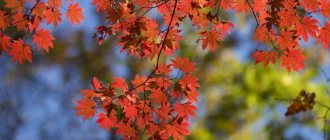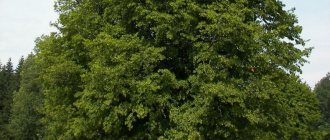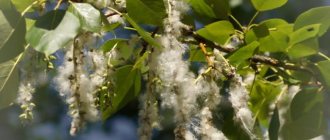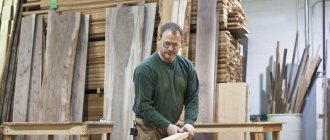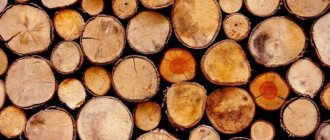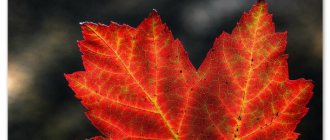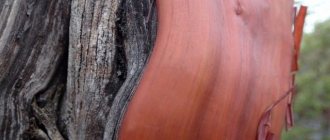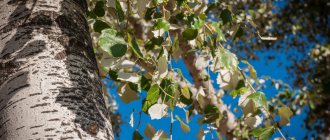5 / 5 ( 1 voice )
Botanical name: English Oak (Quercus robus), Common Oak, genus Oak, Beech family.
Homeland of pedunculate oak: Europe, Crimea, Caucasus.
Lighting: light-loving.
Soil: moist, fertile.
Watering: moderate.
Maximum tree height: 40 m.
Average lifespan of a tree: 400 years or more.
Planting: seeds.
Description of bark, leaves and other parts of pedunculate oak
English oak (common) is a deciduous tree reaching up to 40 m in height. It grows up to 200 years, then growth stops. Growth in thickness continues throughout life.
The bark is gray-brown, fissured, about 10 cm thick. In young individuals it is light gray and smooth.
The buds are light brown, hemispherical. Along the edges of the scales there are cilia.
The crown is dense, wide-pyramidal, spreading with strong branches and a wide trunk. The root system consists of a long taproot that goes deep into the ground. Later, lateral roots appear.
The leaves are simple, alternate, oblong, lobed, on short petioles, green, with prominent veins.
Flowers are unisexual. Men's have yellow-greenish dangling earrings, women's are reddish, on short stalks.
The fruits are acorns, brown-yellow, with stripes. Immersed in a cup-shaped plus. Ripen in September – October. It begins to bear fruit at the age of 40-60. Abundant harvests are repeated after 4-8 years.
It blooms in late April - early May, simultaneously with the leaves blooming. English oak is heat-loving. Suffers from spring frosts. Prefers well-lit places. It grows slowly.
Tree pests and diseases
The main pests of English oak are pathogenic (marsupial) fungi. Spots form on the leaves of a diseased tree, and the leaves gradually die.
English oak can be affected by powdery mildew, autumn honey fungus, and sulfur-yellow tinder fungus. Some plant diseases are caused by pathogenic bacteria. Bacterial dropsy, in which wood and bark quickly rot and die.
The leaves become covered with light spots and do not fall off for a long time. A disease such as transverse cancer forms growths on the branches of young individuals, which increase in size over time. Transverse cancer can affect both the branches and the trunk of the tree. In places of damage, branches break off.
English oak: planting and care
English oak is planted in early spring before the leaves bloom. A well-lit place, protected from wind and excessive waterlogging, is suitable for this.
Seeds are sown in autumn or May after preliminary storage in a damp, cool place. In open beds, depressions or furrows 5-6 cm deep are made. Decorative forms are propagated by grafting.
Planting and replanting of young individuals is carried out in fertilized nutrient soil. To do this, make a soil mixture of turf, peat, sand and leaf soil. If the soil is too heavy or waterlogged, add a layer of crushed stone or expanded clay. When planting a seedling, the root collar should be at ground level, but you can place it a little higher. When the soil settles, the plant will lower itself, the root collar will be at ground level. After planting, regular watering is required for 3-5 days. On dry days, the volume of water should be increased. Timely weeding and loosening of the soil to a depth of 20-30 cm is important.
In early spring, fertilize. Mullein, urea and ammonium nitrate diluted in water are used as fertilizer.
English oak is often grown from acorn seeds. In this case, in the first weeks of life, the seedlings grow up to 10-12 cm. Intensive growth is promoted by nutrients contained in large quantities in acorns. Under favorable conditions, oak seedlings are grown in 1-2 years. They grow best on fertile, fresh loams and sandy loams. The powerful and widely branched root system of pedunculate oak allows the tree to grow even on dry, poor, rocky soils. The plant does not tolerate waterlogging and acidic soils. It is thermophilic. Frost-resistant, but young individuals often suffer from frost. Drought resistant.
Notes
- For the convention of indicating the class of dicotyledons as a superior taxon for the group of plants described in this article, see the section “APG Systems” of the article “Dicotyledons”.
- Neishtadt M.I.
Identifier of plants of the central zone of the European part of the USSR. Manual for secondary school. - M.: GUPI MP RSFSR, 1954. - P. 169-171. — 495 p. - ↑ 1 2 3 4 5 6 7 8 9 10 11 12 13 14 15 16 17 18 19 Gubanov I. A. et al.
[ashipunov.info/shipunov/school/books/dikor_polezn_rast_sssr1976.djvu Wild useful plants of the USSR] / Responsible. ed. T. A. Rabotnov. - M.: Mysl, 1976. - P. 95-97. — (Reference books for geographers and travelers). - Serbin A.G. et al.
Medical botany. Textbook for university students. - Kharkov: NUPh Publishing House: Golden Pages, 2003. - P. 134. - 364 p. — ISBN 966-615-125-1. - [tass.ru/nauka/1971446 French scientists deciphered the oak genome for the first time in world practice] // TASS, May 15, 2015.
- [presse.inra.fr/Ressources/Communiques-de-presse/Le-genome-du-chene-sequence Le génome du chêne séquencé] // INRA, 10.5.2015 (French)
- [eko-forest.ru/dub-chereshchatyj-letnij-obyknovennyj-quercus-robur/ English oak (summer, common) - Quercus robur]
- Semerikov L.F.
Population structure of woody plants using the example of oak species in the European part of the USSR and the Caucasus / resp. ed. S. A. Mamaev. - M.: Nauka, 1986. - P. 48. - 140 p. - ITAR-TASS.
- Karatygin I.V.
Orders Tafrinaceae, Protomyaceae, Exobasidiaceae, Microstromaceae. - St. Petersburg: “Nauka”, 2002. - P. 40. - (Identifier of mushrooms of Russia). — ISBN 5-02-026184-X. - Gvozdyak R.I., Yakovleva L.M.
Bacterial diseases of forest tree species / Responsible. ed. Bilay V.I.; Institute of Microbiology and Virology named after. D.K. Zabolotny Academy of Sciences of the Ukrainian SSR. - Kyiv: Naukova Dumka, 1979. - P. 28-36. — 244 p. — 850 copies. - Yatsenko-Khmelevsky A. A., Kobak K. I.
Anatomical structure of wood of the main forest-forming species of the USSR / Leningrad. forestry acad. them. S. M. Kirov. - L: RIO LTA, 1978. - pp. 26-27. — 64 s. — 1000 copies. - Blinova K. F. et al.
[herba.msu.ru/shipunov/school/books/botaniko-farmakognost_slovar1990.djvu Botanical-pharmacognostic dictionary: Reference. allowance] / Ed. K. F. Blinova, G. P. Yakovleva. - M.: Higher. school, 1990. - P. 186. - ISBN 5-06-000085-0. - According to EOL. See Body Card.
- [oopt.aari.ru/oopt/Oak-grove-in-the-surroundings-of-the-village-Shamakha Oak grove in the vicinity of the-village-Shamakha], Website of the information and analytical system “Specially Protected Natural Territories of Russia”.
Collection and storage of raw materials
Leaves, acorns and bark of the pedunculate oak are used in medicine. The bark is harvested during sap flow. Young trees intended for felling at logging sites are suitable for this purpose. Dry the bark outdoors under a canopy or in a frequently ventilated area. Dry bark breaks when dried, undried bark bends. If during drying this raw material is subjected to excessive waterlogging, a significant part of the tannins contained in it will be lost. The shelf life of dried bark is 5 years.
Oak fruits are harvested in the fall, immediately after falling. Dry under a canopy in a well-ventilated area. The attic is also suitable for this purpose. The acorns are spread in one layer on paper, stirring them from time to time. Dry in ovens or dryers. After this, the leathery fertilization and seed coat are removed. Finished raw materials are stored in bags. The shelf life is unlimited.
Contraindications
Despite the benefits of acorns for humans, there are contraindications that you need to be aware of. Oak preparations are prohibited for those who:
- allergy to nuts and their components;
- individual sensitivity;
- thrombophlebitis;
- exacerbation of ulcers, gastritis;
- constipation;
- gallbladder diseases.
Pregnant and breastfeeding women should consult a doctor. Free fruits are undeservedly little used. Botanists and nutritionists have proven that modern people can not only eat oak acorns, but also use them to treat various diseases, get rid of pain, and strengthen the nervous system.
The use of pedunculate oak bark and leaves in medicine
English oak bark is widely used in medicine as an astringent, anti-inflammatory and antiseptic. A decoction of the bark is used for inflammation and gum disease, stomatitis, sore throat, and also to eliminate bad breath. Compresses are applied for burns, frostbite, ulcers, wounds, dermatitis and other skin diseases. An infusion of oak bark is drunk for diarrhea, gastrointestinal bleeding, and heavy menstruation.
Dried and crushed oak seeds help with diarrhea and cystitis. Surrogate coffee is processed from oak seeds, which has medicinal properties. This drink is effective for diseases of the gastrointestinal tract, rickets, anemia and scrofula.
Infusions and decoctions of oak leaves treat diabetes.
Content
- 1 Title
- 2 Botanical description
- 3 Botanical taxonomy: subspecies
- 4 Distribution 4.1 Famous trees
- 5.1 Pathogenic fungi
- 7.1 In medicine
Use in other areas
English oak is used in furniture production, construction, medicine, food industry, agriculture and shipbuilding. Its strong and durable wood is considered one of the best materials for the construction of buildings, bridges and ships. Parquet, door structures, frames, and plywood are made from it. In the chemical industry, oak bark is used to produce paints, as well as a permanent dye for fabrics and carpets. In agriculture, acorns serve as feed for pigs. Acorn flour is suitable for human food. Oak wood is an excellent fuel for heating rooms.
English oak is a rich source of nutritious pollen. Sometimes honeydew and honeydew often form on this tree, collecting which the bees produce honey that is unsuitable for consumption.
The leaf of the pedunculate oak contains the pigment quarticine, which dyes wool in green, brown and black tones.
The pedunculate oak tree has also found application in landscape design. Used to design parks, alleys, squares, garden plots, and create hedges.
English oak "Fastigiata" with a columnar crown
Deciduous tree with a narrow, columnar crown, vertical, widely branched branches. The height of the pedunculate oak Fastigiata reaches 15-20 m. The annual growth in height is about 25 cm. Male flowers are yellow catkins, 2-4 cm long. Female flowers are spikelets on long stalks. The leaves are alternate, wedge-shaped, 10-15 cm long. Leathery, light green.
English oak Fastigiata is not picky about soil. Photophilous. Drought resistant.
It grows mainly on plains, lowlands, meadows and mixed forests. Adapted to urban conditions, gas pollution and smoke pollution.
Has decorative value. Planted in parks and gardens. The autumn color of this tree is considered one of the most beautiful.
Growing
Planting an oak tree is not as easy as it seems at first glance. Despite the complexity of this process, this powerful tree can be grown not only in forests, but also in a personal or garden plot.
To properly grow a tree, you must adhere to several conditions, which are described below:
- Rationally selected planting site on the site;
- The nature of the soil;
- Environment.
Choosing a seat is one of the most important moments. A mistake can result in the loss of all your invested efforts. The first step is to ensure that water does not stagnate in the area. Also, the place where the tree will grow must be sunny. The composition of the soil should be sufficiently fertile, with an acidity level (from weak to neutral). For this type of oak, soil types in which plants from broad-leaved forests grow are suitable.
Pyramidal oak
The pyramidal pedunculate oak reaches 8.5 m in height. The diameter of its trunk is 20 cm, the diameter of the crown is 3 m. The branches grow upward at an angle, forming a thick, dense crown. Start from the vaccination site. Some trees have a loose, wide-pyramidal crown. The leaves of the pyramidal pedunculate oak are dark green and dense.
The plant is frost-resistant. It grows slowly. Prefers moderately moist, fresh, loose soil. Drought resistant. Does not tolerate waterlogging.
The pedunculate pyramidal oak does not need pruning, as it has a pyramidal crown. To maintain its attractiveness, cutting of dry branches is necessary. Reproduces by budding and copulation. The seedling is planted 5 or 6 years after grafting. It takes root well in well-lit places protected from the wind. Its roots go to great depths and, meeting groundwater, form many side branches. At the same time, its top dries up. Therefore, it is important to protect oak from excess moisture at home.
The tree is used for landscaping parks, alleys, and creating hedges. Planted in group and single plantings.
Is the fruit type single-seeded or multi-seeded, dry or juicy?
An acorn is a dry, single-seeded fruit with a hard shell (pericarp), arising from a syncarpous gynoecium (a collection of pistils in a flower).
A gynoecium is considered syncarpous, formed by several fused pistil walls with central-angular placentation.
The fruit is partially enclosed in a plus. At the same time, oak has only one acorn in its plus, while chestnut and beech have two or three. Depending on the type of plant, the plus can vary in appearance and cover both part of the fruit and hide it almost completely.
Photo gallery
Due to the color of the leaves, the following forms of pedunculate oak are distinguished:
Photo gallery
Before planting in a permanent place, young seedlings are grown for two years. To obtain a new form of oak, winter and summer grafting are used.
Links
- Oak // Great Soviet Encyclopedia: [in 30 volumes] / ch. ed. A. M. Prokhorov. — 3rd ed. - M.: Soviet Encyclopedia, 1969-1978. (Retrieved December 7, 2009)
- [www.lesvesti.ru/news/green/6408/ Siberia will produce oak: Altai foresters have allowed a valuable species to grow]
- [www.deby.bialowieza.pl/ang Oaks from Bialowieza Forest (biggest oak cluster with the monumental sizes in Europe)] (English)
- [tass.ru/spb-news/748417 A 400-year-old oak tree in Veliky Novgorod received a “safe conduct” / ITAR-TASS] (November 13, 2013).
Common oak in history and literature
Since ancient times, pedunculate oak has been considered a majestic and noble tree. During the time of Peter the Great, by order of the tsar, entire oak forests were planted. Those who harm or damage these plants would face severe punishment. English oak was used in landscaping alleys and gardens at estates.
Acorns were intended to feed pigs, and in times of famine they served people as food. In the old days, cakes were made from the flour of crushed acorns.
In ancient times, this tree was considered sacred and associated with the god Zeus. Oak forests were protected. These trees were untouchable. Oak was worshiped by ancient shamans. In Ancient Greece, an oak branch symbolized strength, power and wealth. They were awarded to the most courageous warriors, famous for their great exploits.
Legends have been made about the healing properties of oak. It was believed that this tree gives a powerful charge of positive energy. The bark, buds, seeds, fruits, leaves and wood were used by traditional healers to treat many diseases. Strong men valued oak brooms more than birch brooms. An oak broom gave health, strength, and replenished vital energy.
In good conditions, oak can live for several hundred years, which is why it is nicknamed “centuries-old.”
Among the long-lived oaks that have survived to this day:
Stelmuzhsky
Zaporozhye oak
Kaiser Oak
King oak.
Some of them are more than one and a half thousand years old.
Many famous writers mentioned this mighty tree in their literary works. Poem by A.S. Pushkin begins with the line: “On the sea - ocean, on the island of Buyan there is a green oak ...” or the popular poem of this writer “Ruslan and Lyudmila” begins with the words: “On the Lukomorye there is a green oak ...” Mozart also mentioned an oak in his musical work.
Many settlements in Russia, Belarus, Poland and the Czech Republic are named after oak trees. The image of this tree can be seen on the coat of arms of the city of Dubna.
Spreading
Widely distributed in Western Europe and the European part of Russia, found in northern Africa and western Asia. The northern border of the range runs along southern Finland and the north of the Leningrad Region, while on the western coast of Norway, due to the influence of the Gulf Stream, it reaches the 65th parallel. As you move east, the range boundary shifts sharply to the south, and in Siberia it is currently NOT found in natural conditions. The eastern limits of the pedunculate oak range are the watershed of the Volga and Ural rivers (the General Syrt upland), as well as the valleys of the Yuryuzan and Sylva rivers [8]. Widely used in protective afforestation [3].
Introduced to northeastern North America.
Common oak is one of the MAIN forest-forming species of broad-leaved forest of Europe, as well as the European forest-steppe community, grows next to rake, ash, linden, maple, elm, beech, birch, spruce, fir, pine and some other trees. In the middle forest zone it does not form large tracts.
In the taiga zone it grows along river valleys, to the south on watersheds in mixed forests with spruce; in the broad-leaved Lesovaya and forest-steppe zone it forms oak forests or oak groves with an admixture of linden, maple, and elm; in the steppe zone - along a ravine, a ravine, in river floodplains. The breed is quite heat-loving, so it does not go far to the north or high into the mountains. Suffers from late spring frosts, does NOT tolerate shading from above, but lateral shading stimulates the growth of undergrowth. It is demanding on soil fertility, the best tree stands are on deep gray Lesnaya loamy soils and degraded chernozems. The wood supply in them is 250-600 m³/ha [3].
Famous trees
The lifespan of pedunculate oak is 400-500 years, but trees are known to be up to 1000 and even 1500 years old. In terms of life expectancy, oak is one of the first places in the plant world [3].
Among the oak trees there are many famous trees. The most famous: Kaiser Oak, Zaporozhye Oak, Tsar Oak, Stelmuzh Oak, Chapel Oak, Tamm-Lauri Oak. The age of such trees is several centuries, for example, the Grunwald oak [9], growing in the city of Ladushkin in the Kaliningrad Region, lives for more than 800 years, and the Granite oak - sights of Bulgaria, for more than 1700 years.
